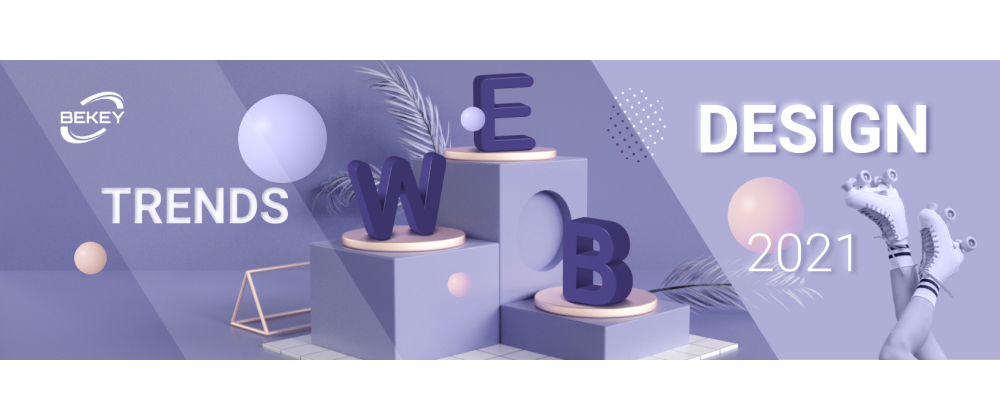Websites start to look different again! At least for businesses who want experiments. We’ve read through trend reports and looked over designs of major brands, checked over the latest awards winners and use cases from popular design studios’ portfolios, and figured out our prediction for web-design trends in 2021.
This article is a part of the, and here, we’ll talk about web-design for people who are tired of homogenous internet pages: Predicting web-design trends for 2021
Interactive web-design + Storytelling
The animation is still considered (and fairly so) a questionable choice from the standpoint of accessibility; some animation still causes motion sickness and even, sometimes, seizures, if it’s done too sharply, too quickly, or too unpredictable. Apart from that, if done wrong, animation adds weight to the website, and that has a significant impact on the conversion rate. But done right, animation can be a way to tell your web-site story and we are here for it.
So, user-activated (scroll-based or click-based animation), requires two things: first, lightweight animation; next, really, really neat content.
The animation must enhance the content, elevate, and empathize with the points in it, but it mustn’t get in the way of a story. So, it’s a combination of calculation—understanding the perfect timing, zooming in or highlighting important things, that need elaboration,—and a pinch of deliberation for it to look and be perceived effortlessly.
Now, you can combine different styles of animation, vertical and rotational, or you can focus on simply telling the story through the scroll. Or add a few additional things, like floating, overlapping elements, or getting deeper in the perspective.
You can add a bit of motion into static hand-drawn pictures. You can make text spark. At this point of exhaustion with unified internet, you can do anything, honestly. (But be careful, when doing that in e-commerce. Please don't overwhelm customers; they are already tired.)
Look in the past
Remember when YouTube could be customized and everybody cringed at people who use black and cyan blue or pink in their designs? Well, these colors—along with cyberpunk palette, are back, along with the collages with large typographic fonts, the glitter, glamour, and all of it?
Matrix-style fonts and large intervals between text, one-paged websites without navigation, modified cursos, —all of these are coming back.
They are coming back slowly: first, with professional designers’ websites and digital studios, then with special editions of Vogue, then with IBM Experiments, newly-founded services for music artists, and new Air Max collection's presentation. We think, in 2021, retro aesthetics on websites would certainly be a more noticeable trend.
Brutalism, almost antidesign
The important distinction between brutalism and antidesign is that brutalism still tries to establish more clarity: by reduction of visible elements and showing off everything users need to know on one page. Yes, websites in brutalism sometimes don’t have a hierarchy, and yes, it’s shocking at first to see a large red or yellow or some other bright color block with unified topography.
But in the end, such websites are still pleasing to look at: they relate to minimalism in a sense of “throwing away everything that doesn’t spark joy” philosophy, and, at the same time, they disregard the homogenous status quo. Refreshing.
Antidesign doesn’t bother to deliver clarity. It’s often a complex interface that comprises giant piles of links, incompatible (really) colors, disorientation, and extreme rawness. Antidesign is considered to be an “untamed” part of brutalism, so instead of getting rid of classic UI elements to strip the page down to truly important bits, web-designers in antidesign create new, asymmetrical, confusing design elements. Often, their main task is to crack the convention apart, along with the and user’s behavioral patterns this convention helps create.
And they do succeed in it, antidesign creators. Antidesign is often a tool of humor, an inside joke, or, in other cases, a provocation, rebellion, a call to rethink what we are used to, and so on.
Both antidesign and brutalism have been here for some years. Brutalism started as an architectural style and then sipped out on the Internet. Old websites’ designs might be called brutalist, but they were buried under the practicality of the material design, and then flat design. (By the way, skeuomorphism is also coming back, this time in neomorphism form. We think it’s a delight.)
Then, in 2017, when it became obvious that the web will be more uniform, not diverse, as businesses need to be able to re-access the same behavioral patterns over and over again without creating additional “getting used to the interface” pain, brutalism (antidesign—less so) started its revival. And we’re sure at least brutalism will settle more confidently on the web of 2021.
Final thoughts about web-design trends in 2021
We think it’s time for a change in web design. According to the trend report, a large part of American consumers are tired of making decisions so they want to see a clear and concise copy and product descriptions in retail, but another chunk of them wants new things and impressions, so it’s logical to assume brands will at least try to balance between the two. For that, they will need to experiment.
It’s a good time (relatively; there is no good time in a pandemic) for niche products and services to design authentic, local experiences, as people want shops to be where they are and buy from brands that are close and relatable. That requires experiments as well. You can’t win local customers without getting deep into how they feel, what visuals do they like, what makes them comfortable, and at home.
We suppose even B2B brands will start choosing authenticity and honesty (both in design—no stock images, for Christ’s sake; and in copy) over the conventional approach to presenting themselves in abstract words or tech jargon and abstract graphics to match. That doesn’t mean they’ll gonna bathe their websites in glitter—or insert a large-scale animation on their product page as Apple’s been doing it for a long time. That means, they will start using the advantages of the medium. Digital is a powerful tool.
Why, when moving on the Internet, we’ve transformed our business into polished, trivial, and boring web, instead of embracing things that make us and our businesses unique?
That’s a good question for 2021.














Top comments (1)
That's still a good article and still a good question. I love brutalism and think we as developers could do more of that - something related to art, even, while developing something. Of course, this relies on PM's, designers, etc
But yeah, I think we could experiment more.